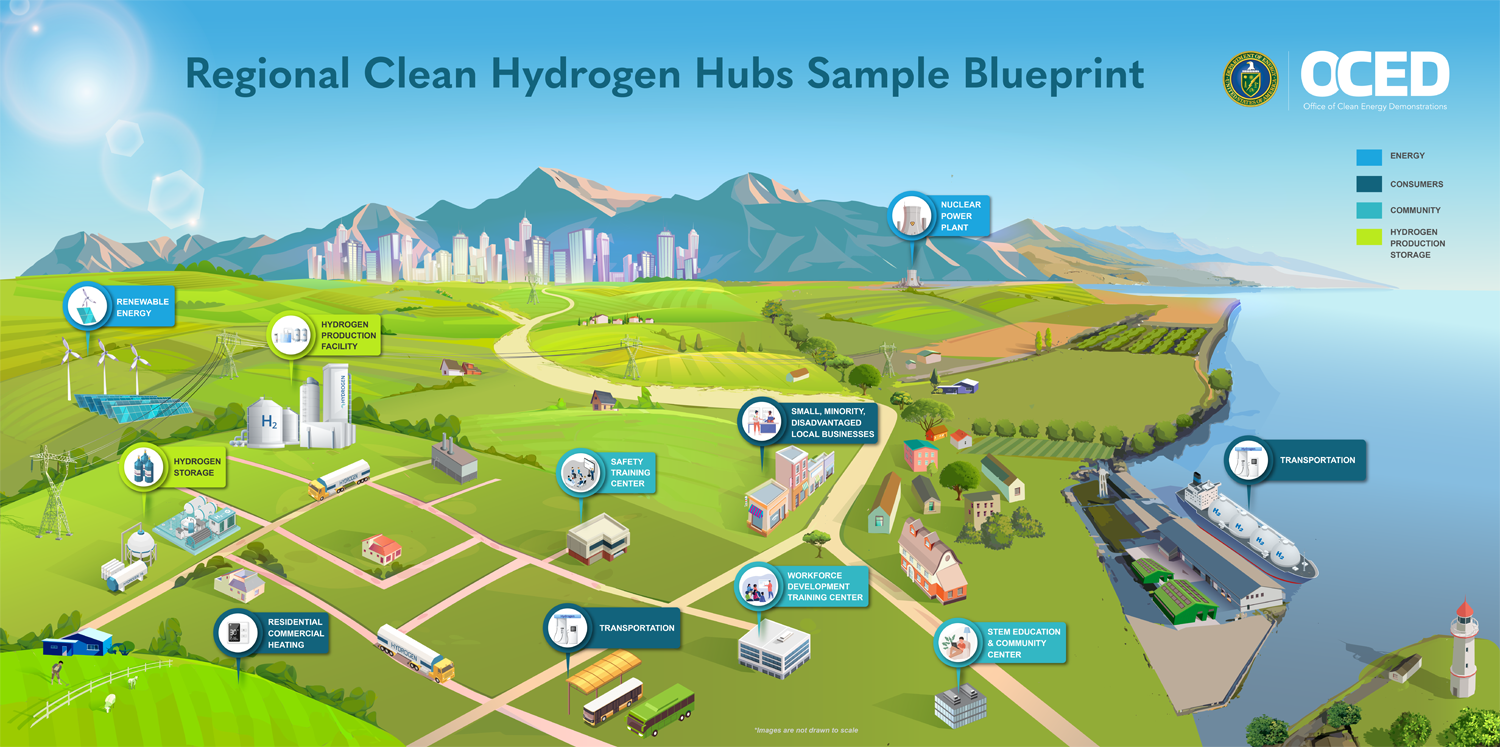Pioneering the Future of Energy: The Heartland Hydrogen Hub
In the heartland of the United States, a groundbreaking initiative is emerging, poised to redefine the landscape of clean energy. The Heartland Hydrogen Hub (HH2H), selected by the U.S. Department of Energy, stands at the forefront of a transformative energy movement. This collaborative initiative is not just a project; it’s a vision of a future powered by low-carbon hydrogen, encapsulating the aspirations of a nation committed to environmental sustainability and innovation.
Contents

Stretching across the diverse terrains of Minnesota, Montana, North Dakota, South Dakota, and Wisconsin, HH2H is much more than a regional endeavor. It’s a beacon of hope for a cleaner, greener future, blending the promise of decarbonized supply chains with the creation of new, clean energy jobs. This is a story of collaboration and ambition, where leading energy entities and educational institutions unite with a shared goal: to harness the power of clean hydrogen for a sustainable tomorrow.
At its core, The Heartland Hydrogen Hub (HH2H) is not just about producing hydrogen. It’s about reimagining how we power our industries, cultivate our lands, and energize our communities. With a focus on reducing CO2 emissions, the hub integrates an array of technologically advanced clean hydrogen projects, touching every aspect of our lives, from the food we grow to the energy that powers our homes. By leveraging various energy sources, HH2H is set to deliver clean hydrogen to numerous end-use markets, including industrial operations and power generation, creating a ripple effect of environmental benefits.
As we embark on this journey with The Heartland Hydrogen Hub (HH2H), we step into a realm where innovation meets purpose, where the goals of economic growth, environmental stewardship, and community engagement converge. This initiative is more than just an energy project; it’s a testament to human ingenuity and our relentless pursuit of a better, cleaner world.
Overview of the Heartland Hydrogen Hub
The Heartland Hydrogen Hub (HH2H) represents a pioneering step into the future of renewable energy, marking a significant leap towards a sustainable and environmentally conscious society. This initiative, spanning the American heartland states of Minnesota, Montana, North Dakota, South Dakota, and Wisconsin, embodies a powerful commitment to not just producing hydrogen, but doing so in a way that fundamentally transforms regional energy dynamics.
At the heart of The Heartland Hydrogen Hub (HH2H)’s mission is the production of low-carbon hydrogen. This endeavor is not just about tapping into a new energy source; it’s about reshaping entire supply chains to be more environmentally friendly. By focusing on low-carbon hydrogen, The Heartland Hydrogen Hub (HH2H) positions itself as a key player in the global movement towards decarbonization, aligning with broader efforts to mitigate the impacts of climate change. A similar model would be the Appalachian Hydrogen Hub.

But the ambitions of HH2H extend far beyond environmental stewardship. The initiative is also a catalyst for economic revitalization, poised to create a myriad of clean energy jobs across its multi-state span. In doing so, HH2H becomes more than an energy project; it’s a vehicle for regional development and job creation, offering new opportunities in a burgeoning sector of the economy.
The Heartland Hydrogen Hub (HH2H)’s approach is multifaceted, targeting various sectors for decarbonization, including agriculture and industrial manufacturing. By integrating a range of clean hydrogen projects that utilize diverse energy sources, The Heartland Hydrogen Hub (HH2H) aims to supply clean hydrogen to multiple end-use markets. These efforts are not just about energy production but are geared towards creating a sustainable ecosystem where energy efficiency and environmental responsibility go hand in hand.
This comprehensive initiative stands as a testament to what can be achieved when innovation meets environmental consciousness. The The Heartland Hydrogen Hub (HH2H) is not just a project; it’s a blueprint for the future of energy, demonstrating how strategic collaboration and cutting-edge technology can pave the way for a cleaner, more sustainable world.
Key Partners and Their Roles
The Heartland Hydrogen Hub (HH2H) is not just an ambitious project but a symphony of collaboration among key players, each bringing unique strengths and expertise to the table. At the forefront of this initiative is the University of North Dakota’s Energy & Environmental Research Center (EERC), a globally recognized leader in developing cleaner, more efficient energy technologies. EERC’s role is pivotal in steering the project’s research and technological advancements, ensuring that HH2H remains at the cutting edge of clean hydrogen production.
Joining EERC in this groundbreaking venture are industry giants like Marathon Petroleum Corporation (MPC) and TC Energy. MPC, renowned for its integrated downstream energy operations, brings to the project an unparalleled depth of knowledge in refining systems and energy marketing. Their expertise is crucial in navigating the complex energy landscapes and ensuring the efficient distribution and utilization of the produced hydrogen.

TC Energy, a major North American energy company, lends its vast experience in developing and operating energy infrastructure across North America. Their involvement is key to establishing the necessary infrastructure for the hydrogen hub, encompassing everything from pipelines to energy storage solutions. TC Energy’s role is instrumental in bridging the gap between hydrogen production and its end-use, ensuring a seamless flow from source to consumer.
Xcel Energy, a significant electricity and natural gas company, contributes its extensive resources in electricity and natural gas services. With operations across various states, Xcel Energy is instrumental in integrating clean hydrogen into the existing energy mix. Their involvement is crucial in leveraging diverse energy sources, including nuclear, solar, and wind, for hydrogen production, thereby bolstering the hub’s commitment to a diversified, sustainable energy portfolio.
Together, these partners form the backbone of the The Heartland Hydrogen Hub (HH2H), each playing a distinct yet interconnected role. Their combined expertise spans the entire energy spectrum, from production to distribution, making the Heartland Hydrogen Hub a beacon of collaboration and innovation in the clean energy sector. This partnership not only exemplifies teamwork but also highlights the power of collective effort in driving forward the clean energy agenda.
Project Details and Goals
The Heartland Hydrogen Hub (HH2H) is a beacon of innovation and progress, marking a significant stride in the journey towards a sustainable energy future. The project is distinguished by its ambition to establish a network of clean hydrogen production and utilization across the heartland states of the U.S., a mission that goes beyond conventional energy projects.
One of the most striking aspects of The Heartland Hydrogen Hub (HH2H) is its commitment to establishing three clean hydrogen “nodes.” These nodes are not merely production centers; they are hubs of innovation, demonstrating sustainable business models and potential for growth. This approach is revolutionary in its scope, integrating a variety of resources and markets to create a comprehensive clean hydrogen ecosystem.
A key facet of the The Heartland Hydrogen Hub (HH2H)’s mission is its focus on diversifying energy sources for hydrogen production. The project aims to utilize a range of renewable and natural resources, tapping into the vast potential of wind, solar, and nuclear energy. This approach is not just about harnessing different energy forms; it’s about creating a resilient and flexible energy infrastructure that can adapt and thrive in a rapidly changing energy landscape.

Moreover, HH2H’s goals extend into the realm of workforce development and economic growth. The project is poised to develop a diverse, highly skilled workforce in the clean energy sector. This is not just about job creation; it’s about nurturing a new generation of energy professionals, equipped with the skills and knowledge to drive the clean energy transition forward.
In aligning with the Department of Energy’s Justice40 Initiative, HH2H also demonstrates a deep commitment to equitable and inclusive development. The project is about more than just clean energy; it’s about ensuring that the benefits of this transition are shared broadly, particularly with disadvantaged communities. This commitment is a testament to the project’s broader vision of not just a cleaner, but a fairer and more equitable energy future.
The Heartland Hydrogen Hub is more than a collection of goals and initiatives. It is a comprehensive blueprint for a future where clean energy is not just a possibility but a reality. With its ambitious targets and innovative approach, HH2H stands as a model for sustainable energy development, not just in the United States but globally.
Community and Economic Impact
The Heartland Hydrogen Hub (HH2H) represents more than an energy project; it embodies a transformative impact on communities and economies. This initiative stands as a testament to the power of energy innovation in catalyzing significant socio-economic changes, particularly in the heartland states of the United States.
A cornerstone of the HH2H’s community impact is its deliberate and strategic engagement with local communities, tribes, and stakeholders. This engagement is not a one-way process but a dynamic, two-way interaction, where community feedback is integral to shaping the project’s outcomes. Such engagement underscores the project’s commitment to not only advancing clean energy but also ensuring that this advancement resonates with and benefits the communities involved. The Pacific Northwest Hydrogen Hub also has similar goals to the benefits for the community and the economic impact of the project.
The HH2H’s economic footprint is substantial, with a promising outlook on job creation and economic growth. The project is set to create a significant number of jobs, both direct and indirect, which translates to a tangible boost in local employment opportunities. This is not just about numbers; it’s about providing quality employment opportunities that contribute to the overall economic health and stability of the region.
In addition to job creation, the HH2H has a profound impact on environmental sustainability. By mitigating the carbon dioxide output of a considerable number of homes annually, the project contributes significantly to reducing the carbon footprint of the region. This environmental benefit extends beyond mere statistics; it represents a crucial step towards a more sustainable and environmentally conscious future for the communities in the heartland states.

The HH2H also places a strong emphasis on educational and skill development, particularly in science, technology, engineering, and mathematics (STEM) fields. By fostering STEM opportunities, especially for minorities and underrepresented groups, the project not only contributes to the current clean energy workforce but also invests in the future generation of energy professionals.
The Heartland Hydrogen Hub is a beacon of hope and progress, not just in terms of clean energy but also in its ability to uplift communities and stimulate economic growth. Its comprehensive approach to community engagement, job creation, environmental sustainability, and educational empowerment underscores the multifaceted benefits that such an energy project can bring to the region.
Broader Context and Significance
The Heartland Hydrogen Hub (HH2H) is not an isolated endeavor; it is a vital component of a larger national and global movement towards clean energy. Its significance extends far beyond the boundaries of the participating states, marking a pivotal moment in the journey towards a sustainable energy future.
HH2H is part of the United States’ broader strategy to develop Regional Clean Hydrogen Hubs (H2Hubs), a visionary initiative under President Biden’s Investing in America agenda. This ambitious plan is not just a commitment to clean energy; it’s a comprehensive approach to reinvigorating American manufacturing and job creation while addressing critical climate and energy security goals.

The H2Hubs, including HH2H, are expected to collectively produce a significant amount of hydrogen annually, contributing substantially to the United States’ 2030 hydrogen production target. This production capability is crucial in reducing emissions from hard-to-decarbonize industrial sectors, which account for a considerable percentage of total U.S. carbon emissions. The collective impact of these hubs is comparable to significantly reducing annual emissions from millions of gasoline-powered cars, underlining their critical role in mitigating environmental impacts.
Additionally, the H2Hubs are a major investment in clean manufacturing and job creation, one of the largest in history. This transformative federal investment is anticipated to be matched by recipients, leveraging nearly $50 billion to strengthen local economies. This financial infusion is about more than just monetary value; it’s about creating and maintaining high-quality jobs, especially those supporting worker organizing and collective bargaining, and slashing emissions that jeopardize public health and pollute local ecosystems.
The HH2H, within this broader framework, also embodies a commitment to equity and inclusivity. It aligns with the President’s vision of an equitable and inclusive clean energy future, implementing comprehensive local benefits and workforce proposals. This approach ensures that the benefits of clean energy are not just limited to a few but are distributed equitably, contributing to healthier communities across the nation.
The Heartland Hydrogen Hub is a critical piece of a larger puzzle. It represents a strategic step towards establishing the United States as a global leader in emerging clean energy industries. Its broader significance lies in its ability to propel the global clean energy transition, create high-quality jobs, and deliver healthier communities, thus strengthening America’s energy security and environmental stewardship.
Conclusion
The Heartland Hydrogen Hub (HH2H) stands as a symbol of a transformative era in energy production and sustainability. This project, extending across the heartland of the United States, is not just about the production of clean hydrogen; it is about redefining the future of energy in a way that aligns with environmental, economic, and social objectives.
At its core, HH2H is a testament to the power of collaborative innovation in the face of global environmental challenges. It demonstrates that through strategic partnerships, cutting-edge technology, and a commitment to sustainability, it is possible to make significant strides in decarbonizing key sectors of our economy, such as agriculture and industrial manufacturing. The initiative is a beacon of hope, showing that environmental responsibility and economic growth can go hand in hand.
Moreover, the impact of the Heartland Hydrogen Hub extends beyond its immediate geographic and sectoral boundaries. As part of a larger network of Regional Clean Hydrogen Hubs, HH2H is a critical component in a nationwide effort to reduce carbon emissions, create jobs, and enhance energy security. This project is a clear example of how local initiatives can contribute to broader national and global goals, setting a precedent for future clean energy projects.
In conclusion, the Heartland Hydrogen Hub is more than an energy project; it’s a bold step towards a cleaner, more sustainable future. It exemplifies the potential of clean hydrogen as a key player in the global energy transition and underscores the importance of collaborative efforts in achieving significant environmental and economic milestones. As the project progresses, it will undoubtedly continue to serve as a model for innovative, sustainable energy development, both in the United States and around the world.


